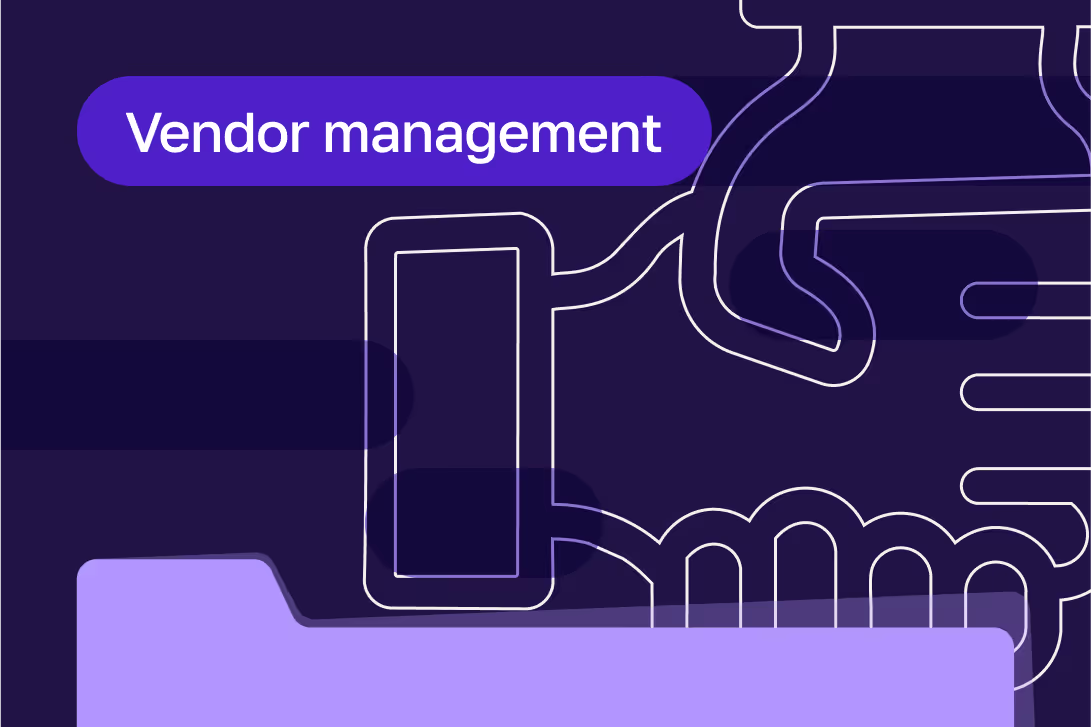What is vendor management in IT and why does it matter?


Listen to this blog as a podcast

.png)
IT teams rely on vendors for just about everything — SaaS tools, cloud platforms, hardware, security services, and more. But without a clear way to manage those relationships, things can get messy fast. You wouldn’t leave the keys to your house with a stranger — so why trust vendors with access to your systems without a plan?
Let’s break down what is vendor management, why it matters, and how to do it right without overcomplicating your process.
What is vendor management in IT?
Vendor management is the process of selecting, onboarding, managing, and evaluating third-party providers that support your IT operations.
This includes everything from negotiating contracts to ensuring vendors meet performance expectations and security requirements.
If your business uses external tools or services — and almost all do — you’re doing vendor management whether you call it that or not. The difference is whether it’s intentional, tracked, and working for you.
Why vendor management matters
The goal isn’t just to keep vendors in check. It’s to make sure you’re getting value, minimizing risk, and staying in control of your tech stack.
When vendor management is done well:
- Contracts are clear and cost-effective
- Tools stay aligned with your business needs
- Security and compliance gaps are caught early
- Vendors are held accountable for performance
Done poorly? You end up overpaying, duplicating tools, and reacting to problems instead of preventing them.
The core components of IT vendor management
Most IT vendor management programs cover four key areas. These aren’t check-box items — they’re the foundation for keeping vendor relationships productive, secure, and aligned with your business goals.
Whether you’re juggling five tools or fifty third-party providers, focusing on these four areas will help you stay in control, avoid surprises, and get more value from every contract.
1. Vendor selection and contracting
Start by selecting the right vendors and negotiating the best terms.
That means defining your requirements, evaluating vendors against them, and negotiating contracts that give you flexibility (like clear SLAs, renewal timelines, and exit clauses).
Tip: Don't just look at features. Look at how easy it is to work with the vendor long-term.
2. Onboarding and integration
Once a vendor is approved, you’ll want a smooth rollout. This includes provisioning access, connecting tools, and ensuring that internal stakeholders are aware of the changes.
This step is often rushed. Slow down just enough to document who owns what, and how success will be tracked.
3. Performance monitoring
Vendor relationships shouldn’t run on autopilot. You need to check in regularly to ensure they’re delivering as promised, especially if their performance impacts user experience, uptime, or security.
Set clear KPIs and review them regularly. Some common ones: response time, system availability, ticket resolution speed, and user satisfaction.
4. Risk and compliance management
Every vendor brings some level of risk. That includes data privacy, uptime reliability, and access to sensitive systems.
A solid vendor management process should include periodic reviews of:
- Access levels
- Data handling practices
- Security certifications (SOC 2, ISO 27001, etc.)
- Incident history
If a vendor is critical to your operations, treat them like an extension of your own security program.
Common vendor management challenges (and how to fix them)
Even experienced teams run into vendor issues. We’ve seen teams discover they’re paying for three different tools that all do the same thing — just because no one was tracking renewals or ownership.
The most common challenges are:
- Lack of visibility: You don’t know who owns what or what tools are even in use.
- Renewals sneak up: Contracts auto-renew without time to review or renegotiate.
- Overlapping tools: Different teams buy similar tools without coordination.
- Underperformance: Vendors stop meeting expectations, but no one’s tracking.
The fix? Centralize vendor info, assign clear owners, and set regular review cycles. You don’t need a heavy process — just something reliable.
Best practices for managing IT vendors
If you’re building or improving your vendor management approach, here are a few things that work:
- Keep a single source of truth: Track all vendors, contracts, owners, and key dates in one place (a shared doc beats email chains).
- Set review checkpoints: Don’t wait until renewal to assess performance — set quarterly or biannual check-ins.
- Involve IT and security early: Before a tool is purchased, IT should understand how it integrates with existing systems and standards.
- Build real relationships: The best vendor outcomes come when there’s mutual trust and open communication, not just ticket threads.
Start simple and stay consistent. You don’t need complex tools to get vendor management right — you just need a clear process and the discipline to follow it. When you treat vendors like long-term partners instead of transactions, everything runs smoother.
A strong vendor strategy = fewer surprises
IT vendor management isn’t just about procurement — it’s about protecting your operations, your budget, and your peace of mind.
Start small. Gain visibility into your current vendors, establish a few clear KPIs, and document your key risks. That’s enough to spot red flags and stay ahead of issues before they impact your team.
Want a simpler way to manage your help desk? Fixify makes that easier, too.
Book a demo today to see for yourself.
Related articles
.avif)
AI in ITSM: The honest challenges Fixify has seen


What is a Help Desk Technician's role?

.avif)
Announcing Smart Personalized Playbooks: Turning tribal knowledge into IT jet fuel

Stay in the loop

Sign up to get notified about our latest news and blogs
.png)